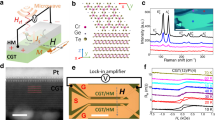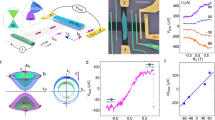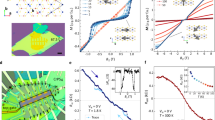Abstract
Pristine graphene is potentially an ideal medium for transporting spin information. Proximity effects—where a neighbouring material is used to alter the properties of a material in adjacent (or proximitized) regions—can also be used in graphene to generate and detect spins by acquiring spin–orbit coupling or magnetic exchange coupling. However, the development of seamless spintronic devices that are based only on proximity effects remains challenging. Here we report a two-dimensional graphene spin valve that is enabled by proximity to the van der Waals magnet Cr2Ge2Te6. Spin precession measurements show that the graphene acquires both spin–orbit coupling and magnetic exchange coupling when interfaced with the Cr2Ge2Te6. This leads to spin generation by both electrical spin injection and the spin Hall effect, while retaining spin transport. The simultaneous presence of spin–orbit coupling and magnetic exchange coupling also leads to a sizeable anomalous Hall effect.
This is a preview of subscription content, access via your institution
Access options
Access Nature and 54 other Nature Portfolio journals
Get Nature+, our best-value online-access subscription
$32.99 / 30 days
cancel any time
Subscribe to this journal
Receive 12 digital issues and online access to articles
$119.00 per year
only $9.92 per issue
Buy this article
- Purchase on SpringerLink
- Instant access to full article PDF
Prices may be subject to local taxes which are calculated during checkout




Similar content being viewed by others
Data availability
Source data in the paper are available via figshare at https://doi.org/10.6084/m9.figshare.22815824 (ref. 58). Any further data used in this study are available from the corresponding authors upon reasonable request.
References
Žutić, I., Fabian, J. & Das Sarma, S. Spintronics: fundamentals and applications. Rev. Mod. Phys. 76, 323–410 (2004).
Maekawa, S., Valenzuela, S. O., Saitoh, E. & Kimura, T. Spin Current (Oxford Univ. Press, 2017).
Manchon, A. et al. Current-induced spin-orbit torques in ferromagnetic and antiferromagnetic systems. Rev. Mod. Phys. 91, 035004 (2019).
Sinova, J., Valenzuela, S. O., Wunderlich, J., Back, C. H. & Jungwirth, T. Spin Hall effects. Rev. Mod. Phys. 87, 1213–1260 (2015).
Bihlmayer, G., Noël, P., Vyalikh, D. V., Chulkov, E. V. & Manchon, A. Rashba-like physics in condensed matter. Nat. Rev. Phys. 4, 642–659 (2022).
Manchon, A., Koo, H. C., Nitta, J., Frolov, S. M. & Duine, R. A. New perspectives for Rashba spin-orbit coupling. Nat. Mater. 14, 871–882 (2015).
Hellman, F. et al. Interface-induced phenomena in magnetism. Rev. Mod. Phys. 89, 025006 (2017).
Žutić, I., Matos-Abiague, A., Scharf, B., Dery, H. & Belashchenko, K. Proximitized materials. Mater. Today 22, 85–107 (2019).
Novoselov, K. S., Mishchenko, A., Carvalho, A. & Castro Neto, A. H. 2D materials and van der Waals heterostructures. Science 353, 6298 (2016).
Geim, A. K. & Grigorieva, I. V. Van der Waals heterostructures. Nature 499, 419–425 (2013).
Safeer, C. K. et al. Spin Hall effect in bilayer graphene combined with an insulator up to room temperature. Nano Lett. 20, 4573–4579 (2020).
Benítez, L. A. et al. Tunable room-temperature spin galvanic and spin Hall effects in van der Waals heterostructures. Nat. Mater. 19, 170–175 (2019).
Island, J. O. et al. Spin–orbit-driven band inversion in bilayer graphene by the van der Waals proximity effect. Nature 571, 85–89 (2019).
Herling, F. et al. Gate tunability of highly efficient spin-to-charge conversion by spin Hall effect in graphene proximitized with WSe2. APL Mater. 8, 071103 (2020).
Ghiasi, T. S. et al. Electrical and thermal generation of spin currents by magnetic bilayer graphene. Nat. Nanotechnol. 16, 788–794 (2021).
Wang, Z., Tang, C., Sachs, R., Barlas, Y. & Shi, J. Proximity-induced ferromagnetism in graphene revealed by the anomalous Hall effect. Phys. Rev. Lett. 114, 016603 (2015).
Sierra, J. F., Fabian, J., Kawakami, R. K., Roche, S. & Valenzuela, S. O. Van der Waals heterostructures for spintronics and opto-spintronics. Nat. Nanotechnol. 16, 856–868 (2021).
Han, W., Kawakami, R. K., Gmitra, M. & Fabian, J. Graphene spintronics. Nat. Nanotechnol. 9, 794–807 (2014).
Avsar, A. et al. Colloquium: spintronics in graphene and other two-dimensional materials. Rev. Mod. Phys. 92, 21003 (2020).
Tombros, N., Jozsa, C., Popinciuc, M., Jonkman, H. T. & van Wees, B. J. Electronic spin transport and spin precession in single graphene layers at room temperature. Nature 448, 571–574 (2007).
Ghiasi, T. S., Kaverzin, A. A., Blah, P. J. & Van Wees, B. J. Charge-to-spin conversion by the Rashba-Edelstein effect in two-dimensional van der Waals heterostructures up to room temperature. Nano Lett. 19, 5959–5966 (2019).
Wang, Y. et al. Quantum Hall phase in graphene engineered by interfacial charge coupling. Nat. Nanotechnol. 17, 1272–1279 (2022).
Wu, Y. et al. Large exchange splitting in monolayer graphene magnetized by an antiferromagnet. Nat. Electron. 3, 604–611 (2020).
Ghazaryan, D. et al. Magnon-assisted tunnelling in van der Waals heterostructures based on CrBr3. Nat. Electron. 1, 344–349 (2018).
Karpiak, B. et al. Magnetic proximity in a van der Waals heterostructure of magnetic insulator and graphene. 2D Mater. 7, 015026 (2020).
Safeer, C. K. et al. Room-temperature spin Hall effect in graphene/MoS2 van der Waals heterostructures. Nano Lett. 19, 1074–1082 (2019).
Khokhriakov, D., Hoque, A. M., Karpiak, B. & Dash, S. P. Gate-tunable spin-galvanic effect in graphene-topological insulator van der Waals heterostructures at room temperature. Nat. Commun. 11, 3657 (2020).
Yang, B. et al. Electrostatically controlled spin polarization in Graphene-CrSBr magnetic proximity heterostructures. Nat. Commun. 15, 4459 (2024).
Ingla-Aynés, J., Herling, F., Fabian, J., Hueso, L. E. & Casanova, F. Electrical control of valley-Zeeman spin-orbit-coupling–induced spin precession at room temperature. Phys. Rev. Lett. 127, 047202 (2021).
Zollner, K., Gmitra, M. & Fabian, J. Swapping exchange and spin-orbit coupling in 2D van der Waals heterostructures. Phys. Rev. Lett. 125, 196402 (2020).
Offidani, M. & Ferreira, A. Anomalous Hall effect in 2D Dirac materials. Phys. Rev. Lett. 121, 126802 (2018).
Chau, T. K., Hong, S. J., Kang, H. & Suh, D. Two-dimensional ferromagnetism detected by proximity-coupled quantum Hall effect of graphene. npj Quantum Mater. 7, 27 (2022).
Ji, H. et al. A ferromagnetic insulating substrate for the epitaxial growth of topological insulators. J. Appl. Phys. 114, 114907 (2013).
Verzhbitskiy, I. A. et al. Controlling the magnetic anisotropy in Cr2Ge2Te6 by electrostatic gating. Nat. Electron. 3, 460–465 (2020).
Ostwal, V., Shen, T. & Appenzeller, J. Efficient spin‐orbit torque switching of the semiconducting van der Waals ferromagnet Cr2Ge2Te6. Adv. Mater. 32, 1906021 (2020).
Gong, C. et al. Discovery of intrinsic ferromagnetism in two-dimensional van der Waals crystals. Nature 546, 265–269 (2017).
Noah, A. et al. Interior and edge magnetization in thin exfoliated CrGeTe3 films. Nano Lett. 22, 3165–3172 (2022).
Safeer, C. K. et al. Reliability of spin-to-charge conversion measurements in graphene-based lateral spin valves. 2D Mater. 9, 015024 (2022).
Ingla-Aynés, J. et al. Omnidirectional spin-to-charge conversion in graphene/NbSe2 van der Waals heterostructures. 2D Mater. 9, 045001 (2022).
Safeer, C. K. et al. Large multidirectional spin-to-charge conversion in low-symmetry semimetal MoTe2 at room temperature. Nano Lett. 19, 8758–8766 (2019).
Ontoso, N. et al. Unconventional charge-to-spin conversion in graphene/MoTe2 van der Waals heterostructures. Phys. Rev. Appl. 19, 014053 (2023).
Camosi, L. et al. Resolving spin currents and spin densities generated by charge-spin interconversion in systems with reduced crystal symmetry. 2D Mater. 9, 035014 (2022).
Yang, H. et al. Twist-angle tunable spin texture in WSe2/graphene van der Waals heterostructures. Nat. Mater. https://doi.org/10.1038/s41563-024-01985-y (2024).
Taniguchi, T., Grollier, J. & Stiles, M. D. Spin-transfer torques generated by the anomalous Hall effect and anisotropic magnetoresistance. Phys. Rev. Appl. 3, 044001 (2015).
Iihama, S. et al. Spin-transfer torque induced by the spin anomalous Hall effect. Nat. Electron. 1, 120–123 (2018).
Céspedes‐Berrocal, D. et al. Current‐induced spin torques on single GdFeCo magnetic layers. Adv. Mater. 33, 2007047 (2021).
Baek, S. H. C. et al. Spin currents and spin-orbit torques in ferromagnetic trilayers. Nat. Mater. 17, 509–513 (2018).
Salemi, L. & Oppeneer, P. M. Theory of magnetic spin and orbital Hall and Nernst effects in bulk ferromagnets. Phys. Rev. B 106, 024410 (2022).
Villamor, E., Isasa, M., Hueso, L. E. & Casanova, F. Temperature dependence of spin polarization in ferromagnetic metals using lateral spin valves. Phys. Rev. B 88, 184411 (2013).
Kimura, T., Hamrle, J. & Otani, Y. Spin-polarized current induced in a single ferromagnetic strip due to inhomogeneous spin injection. J. Appl. Phys. 97, 076102 (2005).
Zollner, K. & Fabian, J. Engineering proximity exchange by twisting: reversal of ferromagnetic and emergence of antiferromagnetic Dirac bands in graphene/Cr2Ge2Te6. Phys. Rev. Lett. 128, 106401 (2022).
Jaffrès, H., George, J.-M. & Fert, A. Spin transport in multiterminal devices: large spin signals in devices with confined geometry. Phys. Rev. B 82, 140408 (2010).
Zhuo, W. et al. Manipulating ferromagnetism in few‐layered Cr2Ge2Te6. Adv. Mater. 33, 2008586 (2021).
Lee, Y. et al. The magnetic states of a van der Waals ferromagnet CrGeTe3 probed by vector-field magnetic force microscopy. Appl. Phys. Lett. 124, 130601 (2024).
Song, G., Ranjbar, M., Daughton, D. R. & Kiehl, R. A. Nanoparticle-induced anomalous Hall effect in graphene. Nano Lett. 19, 7112–7118 (2019).
Tang, C. et al. Approaching quantum anomalous Hall effect in proximity-coupled YIG/graphene/h-BN sandwich structure. APL Mater. 6, 026401 (2018).
Qiao, Z. et al. Quantum anomalous Hall effect in graphene proximity coupled to an antiferromagnetic insulator. Phys. Rev. Lett. 112, 116404 (2014).
Yang, H. et al. A seamless graphene spin valve based on proximity to van der Waals magnet Cr2Ge2Te6. figshare https://doi.org/10.6084/m9.figshare.22815824 (2024).
Acknowledgements
We thank V. Amin for useful discussions. We acknowledge funding from the Valleytronics Intel Science and Technology Center, from MICIU/AEI/10.13039/501100011033 (Grant No. CEX2020-001038-M), from MICIU/AEI and ERDF/EU (Project Nos. PID2021-122511OB-I00 and PID2021-128004NB-C21), from MICIU/AEI and the European Union NextGenerationEU/PRTR (Project No. PCI2021-122038-2A) and from the European Union’s Horizon 2020 research and innovation programme under Marie Skłodowska-Curie Grant Agreement No. 766025. H.Y. acknowledges support from the National Natural Science Foundation of China (Grant Nos. 62404014, 92164206 and 52261145694). B.M.-G. and M.G. acknowledge support from MICIU/AEI and the European Union NextGenerationEU/PRTR (Grant Nos. RYC2021-034836-I and RYC2021-031705-I, respectively). A.F. acknowledges the support of the University of the Basque Country as a distinguished researcher.
Author information
Authors and Affiliations
Contributions
H.Y. and F. Casanova conceived the study. H.Y. fabricated the samples with the help of F.H. H.Y. performed the electrical measurements with the help of F. Calavalle and F.H. B.M.-G and H.Y. performed the Raman spectroscopy measurements. V.T.P and H.Y. performed the finite element simulations. H.Y., M.G., A.F., L.E.H. and F. Casanova analysed the data and discussed the experiments. All authors contributed to the discussion of the results and their interpretation. H.Y., M.G. and F. Casanova wrote the paper with input from all authors.
Corresponding authors
Ethics declarations
Competing interests
The authors declare no competing interests.
Peer review
Peer review information
Nature Electronics thanks Jing Shi and the other, anonymous, reviewer(s) for their contribution to the peer review of this work.
Additional information
Publisher’s note Springer Nature remains neutral with regard to jurisdictional claims in published maps and institutional affiliations.
Supplementary information
Supplementary Information
Supplementary Notes 1–11 and Figs. 1–9.
Rights and permissions
Springer Nature or its licensor (e.g. a society or other partner) holds exclusive rights to this article under a publishing agreement with the author(s) or other rightsholder(s); author self-archiving of the accepted manuscript version of this article is solely governed by the terms of such publishing agreement and applicable law.
About this article
Cite this article
Yang, H., Gobbi, M., Herling, F. et al. A seamless graphene spin valve based on proximity to van der Waals magnet Cr2Ge2Te6. Nat Electron 8, 15–23 (2025). https://doi.org/10.1038/s41928-024-01267-0
Received:
Accepted:
Published:
Issue date:
DOI: https://doi.org/10.1038/s41928-024-01267-0
This article is cited by
-
Nonlocal electrical detection of reciprocal orbital Edelstein effect
Nature Communications (2025)
-
Emerging spintronics applications of magnetic van der Waals heterostructures
Rare Metals (2025)



